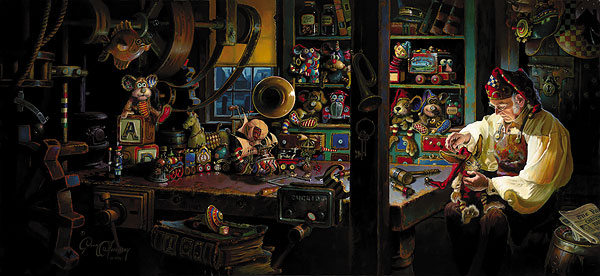The Maximalist aesthetic, the complete use of space for detail and expression. Whether that with be with colors, patterns, or carvings, the piece is taken to its upmost potential of expression through detail. In most popular media, to create a more lively environment, the maximalist design often expresses that “lived-in” feeling to what ever location is being depicted whether that be Studio Ghibli’s Howl’s Moving Castle, Sergio Pablo’s’ Klaus, or Dean Morrissey’s art pieces. Each with depictions of the maximum use of space and design, that leaves its viewer in a state of appreciation, taking the time to look at every detail that comes to attention and how they all connect together in the beautiful combination of abundant expression. No matter where is being seen, there is something to be appreciated by the viewer. More often than not, these depictions include the use of toys in excess.


Howl’s Moving castle, in a scene displaying the bedroom belonging to the story’s protagonist is shown to the left. Here Howl’s room can be seen with heavily decorated toys and trinkets flooding every space in the room. Pendulums, masks, ornaments, and much more are brought to the viewer to sort of signify Howls long life and also childlike demeanor in a physical representation.
Below, there is another snap shot of a film called Klaus, taken within the shop of Santa Clause. Here there are multiple representation of the Victorian era toys. Usually made up of wooden material, with some sort of motion involved either that be pulling a string or turning a crank. All completed with brightly colored coat. Simple in design but deep with expression through clever craftmanship and artistry to bring what is not living to life.
Finally, what brings the topic of discussion to fruition. the works of Dean Morrissey and artist that has been engrained into my subconscious through childhood story telling. Morrissey takes advantage of realism, lighting and maximalist to bring a sort of warmth to the reader and view of his illustrations. Repeatedly, the us of toys occur in his works. Where below, a toy shop is depicted, featuring the a toymaker in the middle of his craft. Reminiscing that Victorian style toys, jack in the box, carts, clowns, ships and many more cluster every crevasse of the toy-makers shop. Which plays in to the artist’s choice of minimalism.
The use of maximalist, and woodcraft offers a beautiful combination where simple material such as wood and textiles are used. Simple materials where through thoughtful designing and planning can create magnificent pieces of work. Even the smallest detail on a piece can bring the onlooker a sense of wonder of what could be seen and appreciated next, also as if it were a small gift of its maker who knew that every detail overs a sense of thoughtfulness in the crafters work. An upcycle project such as this one offers a project that is both thought provoking and skill-building where time and effort are key in to creating a toy piece that is detailed to its fullest potential using intricate detailing and deep colors.

Morrissey, Dean, The Magic Door, 2000, https://artusa.com/product/the-magic-door/


2 Comments. Leave new
I very much enjoyed your explanation of the maximalist aesthetic. I was initially drawn towards your blog post because I was unfamiliar with the term. I knew that the minimalist expression emphasizes an items minimizing size while maintaining its utilitarian purpose, and I expected the maximalist aesthetic to achieve the opposite. I see that the examples you provided are either graphical movies or novels. I was wondering how you will incorporate the visual maximalist idea into a physical, upcycled product for your project?
Hi, your exploration of the Maximalist aesthetic provides a compelling analysis of its use in creating vibrant, lived-in environments, as seen in examples like Howl’s Moving Castle and Klaus. The connection between excessive detailing, the incorporation of toys, and the viewer’s appreciation showcases a nuanced understanding of the impact of Maximalism on visual storytelling. In your perspective, how does the incorporation of Maximalist design, particularly through the use of toys, enhance the storytelling experience in animated films or illustrations?